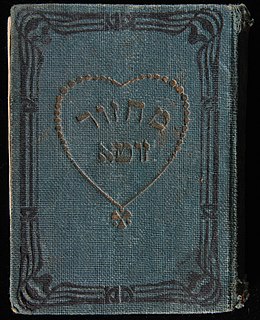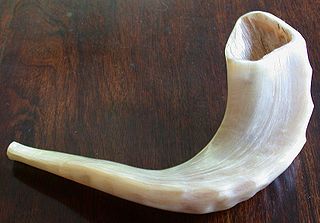Related Research Articles

Jewish holidays, also known as Jewish festivals or Yamim Tovim, are holidays observed in Judaism and by Jews throughout the Hebrew calendar. They include religious, cultural and national elements, derived from three sources: biblical mitzvot ("commandments"), rabbinic mandates, and the history of Judaism and the State of Israel.

A siddur is a Jewish prayer book containing a set order of daily prayers. The word siddur comes from the Hebrew root ס־ד־ר, meaning 'order.'
Asher ben Jehiel was an eminent rabbi and Talmudist best known for his abstract of Talmudic law. He is often referred to as Rabbenu Asher, “our Rabbi Asher” or by the Hebrew acronym for this title, the Rosh. His yahrzeit is on 9 Cheshvan.
Eliezer ben Nathan of Mainz (1090–1170), or Ra'avan, was a halakist and liturgical poet. As an early Rishon, he was a contemporary of the Rashbam and Rabbeinu Tam, and one of the earliest of the Tosafists. He was the son-in-law of Rabbi Eliakim b. Joseph of Mainz, a fellow student of Rashi. Through his four daughters Eliezer became the ancestor of several learned families which exerted a great influence upon religious life in the subsequent centuries. One of his great-grandsons was Asher b. Jehiel (ROSH), father of R. Jacob, author of the Ṭurim.
Kol Nidre is a Hebrew and Aramaic declaration which is recited in the synagogue before the beginning of the evening service on every Yom Kippur. Strictly speaking, it is not a prayer, even though it is commonly spoken of as if it is a prayer. This declaration and its ceremonial accompaniment have been charged with emotional undertones since the medieval period, creating a dramatic introduction to Yom Kippur on what is often dubbed "Kol Nidrei night", with the entire Yom Kippur evening service popularly called Kol Nidrei.

The machzor is the prayer book which is used by Jews on the High Holy Days of Rosh Hashanah and Yom Kippur. Many Jews also make use of specialized machzorim on the three pilgrimage festivals of Passover, Shavuot, and Sukkot. The machzor is a specialized form of the siddur, which is generally intended for use in weekday and Shabbat services.

The High Holidays also known as the High Holy Days, or Days of Awe in Judaism, more properly known as the Yamim Noraim
- strictly, the holidays of Rosh HaShanah and Yom Kippur ;
- by extension, the period of ten days including those holidays, known also as the Ten Days of Repentance ; or,
- by a further extension, the entire 40-day penitential period in the Jewish year from Rosh Chodesh Elul to Yom Kippur, traditionally taken to represent the forty days Moses spent on Mount Sinai before coming down with the second ("replacement") set of the Tablets of Stone.

Tashlikh is a customary Jewish atonement ritual performed during the High Holy Days.

The Ten Days of Repentance are the first ten days of the Hebrew month of Tishrei, usually sometime in the month of September, beginning with the Jewish High Holy Days of Rosh Hashanah and ending with the conclusion of Yom Kippur.
UntannehTokef, Unthanneh Toqeph, Un'taneh Tokef, or Unsanneh Tokef is a piyyut that has been a part of the Rosh Hashanah and Yom Kippur liturgy in some traditions of rabbinical Judaism for centuries. It introduces the Kedusha of Musaf for these days. It is chanted while the Torah ark is open and the congregants are standing. It is the "central poem of the High Holy Day [of the Day of Atonement]." The ArtScroll machzor calls it "one of the most stirring compositions in the entire liturgy of the Days of Awe."

Eleazar ben Kalir, also known as Eleazar HaKalir, Eleazar ben Killir or Eleazar Kalir was a Byzantine Jew and a Hebrew poet whose classical liturgical verses, known as piyut, have continued to be sung through the centuries during significant religious services, including those on Tisha B'Av and on the sabbath after a wedding. He was one of Judaism's earliest and most prolific of the paytanim. He wrote piyutim for all the main Jewish festivals, for special Sabbaths, for weekdays of festive character, and for the fasts. Many of his hymns have found their way into festive prayers of the Ashkenazi Jews' synagogal rite.
Kalonymos or Kalonymus is a prominent Jewish family who lived in Italy, mostly in Lucca and in Rome, which, after the settlement at Mainz and Speyer of several of its members, took during many generations a leading part in the development of Jewish learning in Germany. The family is according to many considered the foundation of Hachmei Provence and the Ashkenazi Hasidim.
Nishmat is a Jewish prayer that is recited during Pesukei D'Zimrah between the Song of the Sea and Yishtabach on Shabbat and Yom Tov. It is also recited during the Passover seder.
The Thirteen Attributes of Mercy or Shelosh-'Esreh Middot HaRakhamim as enumerated in the Book of Exodus are the Divine Attributes with which, according to Judaism, God governs the world.

Rosh HaShanah is the Jewish New Year. The biblical name for this holiday is Yom Teruah, literally "day of shouting or blasting." It is the first of the Jewish High Holy Days, as specified by Leviticus 23:23–25, that occur in the late summer/early autumn of the Northern Hemisphere. The High Holy Days comprises both Rosh HaShanah and Yom Kippur.
El Nora Alila, also transliterated as Ayl Nora Alilah, is a piyyut that begins the Ne'ilah service at the conclusion of Yom Kippur. The piyyut is recited as part of the Sephardic and Mizrahi liturgy, and has been adopted by some Ashkenazic communities.
Yannai was an important payyetan who lived in the late fifth-early sixth century in the Galilee in Byzantine Palestine. Sometimes referred to as the "father of piyyut," his poetry marks the beginning of the Classical Period of piyyut that ranged from the fifth-eighth centuries. He was the first poet of piyyut to sign his name in an acrostic, to use end-rhyme, and to wrote for weekly services. According to Laura Lieber, the liturgical form most associated with Yannai is the qedushta, which embellishes the first 3 blessing of the Amidah.
In Judaism, a neder is a kind of vow or oath. The neder may consist of performing some act in the future or abstaining from a particular type of activity of the person's choice. The concept of the neder and the Jewish law related to it, is described at the beginning of the parashah of Matot.
Solomon ben Judah ha-Bavli was a 10th-century Jewish liturgist.
References
- ↑ Nulman, Macy, Encyclopedia of Jewish Prayer (1993, NJ, Jason Aronson) s.v. Unetaneh Tokef, page 332 [Apart from this one story, Rabbi Amnon is utterly unknown to history, nor has any name been attached to the archbishop in the story, and Kalonymus is possibly the true author of the prayer].
- ↑ Rosh Hashanah i. § 4, in the Vilna edition of the Talmud, folio 36a